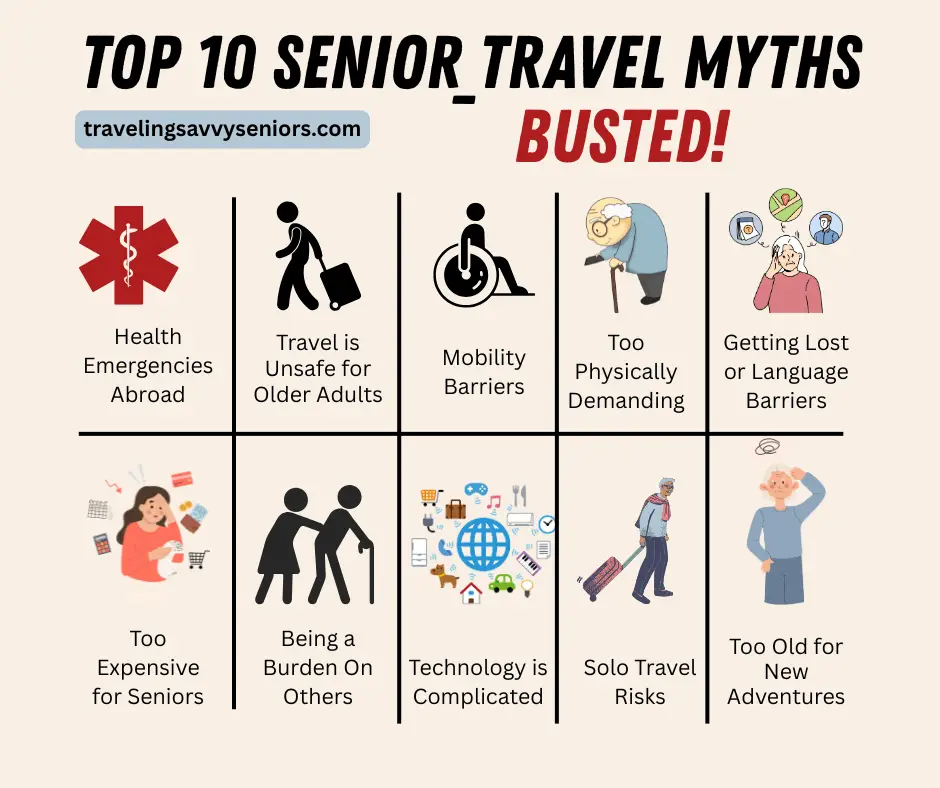Did you know that 1 in 4 adults in the U.S. lives with a disability? Whether you experience reduced mobility, chronic pain, or fatigue, travel is still possible with the right planning. If you’re over 60 and dreaming of a getaway but need to consider accessibility, this guide is for you.
A well-planned vacation balances rest, exploration, and ease. With a few simple adjustments, you can enjoy new experiences, explore beautiful destinations, and travel comfortably. In this guide, I’ll show you step by step how to plan an accessible vacation—so you can travel with confidence and peace of mind!
Why Accessibility and Rest Matter in Travel
Taking breaks while traveling isn’t a luxury—it’s a necessity. If you’re dealing with mobility limitations or just want a stress-free trip, finding the right balance between adventure and relaxation can make or break your vacation. Whether you use a wheelchair, cane, or just need to take it slow, choosing accessible destinations and accommodations can ensure your trip is fun rather than frustrating. Let’s dive into how to make your travels smooth, enjoyable, and full of great memories!
1. Choosing Senior-Friendly and Accessible Destinations
Not all destinations are created equal when it comes to accessibility. Some cities and attractions are built with ramps, smooth pathways, and easily accessible public transportation, while others have cobblestone streets and endless staircases. If you have mobility issues, selecting the right place can be a game-changer.
Best Accessible Travel Destinations
Here are a few top picks for wheelchair-friendly, senior-friendly destinations:
- Washington, D.C. – Known for its wheelchair-accessible museums, smooth sidewalks, and reliable public transportation, it’s a fantastic choice for history buffs.
- San Diego, California – Beautiful beaches with accessible boardwalks, a mild climate, and attractions like Balboa Park that offer wheelchair rentals.
- Vienna, Austria – A surprisingly accessible European city with smooth pathways, step-free trams, and wheelchair-friendly cultural sites.
- Sydney, Australia – One of the most disability-friendly cities, featuring ramps, accessible ferries, and beautiful outdoor spaces with easy navigation.
- Barcelona, Spain – Flat streets, accessible metro stations, and plenty of step-free entrances make this a great spot for seniors.
Tip: Before booking a trip, check Access Earth, a website dedicated to reviewing accessible locations worldwide.

2. Booking the Right Accommodations: Finding Accessible Hotels
Nothing is worse than arriving at your hotel and realizing there’s no elevator or that the “accessible” bathroom isn’t really accessible. Avoid that hassle by double-checking before booking.
What to Look for in an Accessible Hotel
- Step-free entry – Look for automatic doors, ramps, or elevators.
- Spacious rooms – Wide doorways (at least 32 inches) and enough space to move comfortably.
- Roll-in showers – These make bathing so much easier than trying to step over a tub.
- Grab bars and lower sinks – Essential for stability and convenience.
- Accessible dining areas – No stairs or narrow spaces between tables.
Some hotel chains are known for their accessibility, like Marriott, Hyatt, and Hilton, which often have great wheelchair-accessible rooms.
Pro Tip: Use AccessibleGO to find and book verified accessible hotels.
3. Planning Rest Breaks: Pacing Yourself for a Relaxing Trip
Even the most exciting trip can turn into a nightmare if you overdo it. The trick? Building rest periods into your itinerary so you don’t burn out.
How to Build Breaks into Your Travel Schedule
- Plan for downtime every afternoon – Whether it’s a nap or just sitting in a café, you’ll be grateful for the break.
- Use accessible transportation – Don’t wear yourself out walking when taxis, buses, and accessible shuttles are available.
- Choose attractions with seating – Museums, botanical gardens, and scenic train rides let you explore while resting when needed.
- Stay hydrated and bring snacks – Low energy? A quick snack can make all the difference.
Hack: Download Wheelmap to find accessible rest stops, benches, and wheelchair-friendly attractions nearby.
4. Finding Accessible Tours and Activities
Not every tour is senior-friendly, but many companies now offer guided tours designed for travelers with mobility concerns.
Best Accessible Tours
- River Cruises – These offer sightseeing without long walks. Viking and AmaWaterways both have wheelchair-friendly ships.
- Hop-on, hop-off buses – Many cities have wheelchair-accessible buses with lifts and priority seating.
- National Park Tram Tours – Many U.S. National Parks, like Yellowstone and the Grand Canyon, have accessible guided tours.
- Beach Wheelchair Rentals – Coastal cities like Miami and San Diego offer free or low-cost beach wheelchairs.
Budget Tip: The National Park Service offers free lifetime access passes for U.S. citizens with disabilities.
5. Budget-Friendly Travel Tips for Seniors with Mobility Issues
Traveling with mobility concerns doesn’t have to break the bank. Here’s how to save money while staying comfortable:
- Look for senior discounts – Many airlines, train services, and hotels offer discounts for travelers over 60.
- Use public transit – Cities like London, Paris, and New York have wheelchair-friendly subway systems.
- Book flights with free assistance – Airlines offer free wheelchair assistance and early boarding—just request it when booking.
- Stay in vacation rentals – Platforms like Airbnb allow you to filter for accessible properties at lower prices than hotels.
Bonus Tip: Use Rome2Rio to find the cheapest, most accessible transportation options worldwide.
6. Safety Tips for Senior Travelers with Mobility Issues
Safety should always come first when traveling with mobility concerns. Here’s how to ensure a smooth and worry-free trip:
- Carry a medical alert card – List emergency contacts and any medical conditions.
- Bring extra medications – Always carry a few extra days’ worth of medication in case of delays.
- Use a GPS tracker – Devices like Apple AirTags can be placed in bags or mobility aids in case they get lost.
- Get travel insurance – Choose a policy that covers medical emergencies and mobility equipment.
- Avoid peak travel times – Airports and tourist spots are less crowded in the morning and on weekdays.
Resource: Use SafetyWing to find senior-friendly travel insurance options.

Final Thoughts: Plan an Accessible Vacation and Make Travel Work for You
Traveling with mobility issues doesn’t mean giving up adventure—it just means adjusting how you do it! By choosing accessible destinations, booking the right accommodations, planning rest breaks, and taking advantage of senior-friendly tours, you can have an amazing trip without feeling exhausted.
Have any personal travel tips or experiences? Drop them in the comments—I’d love to hear from you! And if you want more expert travel advice tailored for savvy senior travelers, subscribe to our newsletter.
Turning Dreams into Destinations.





